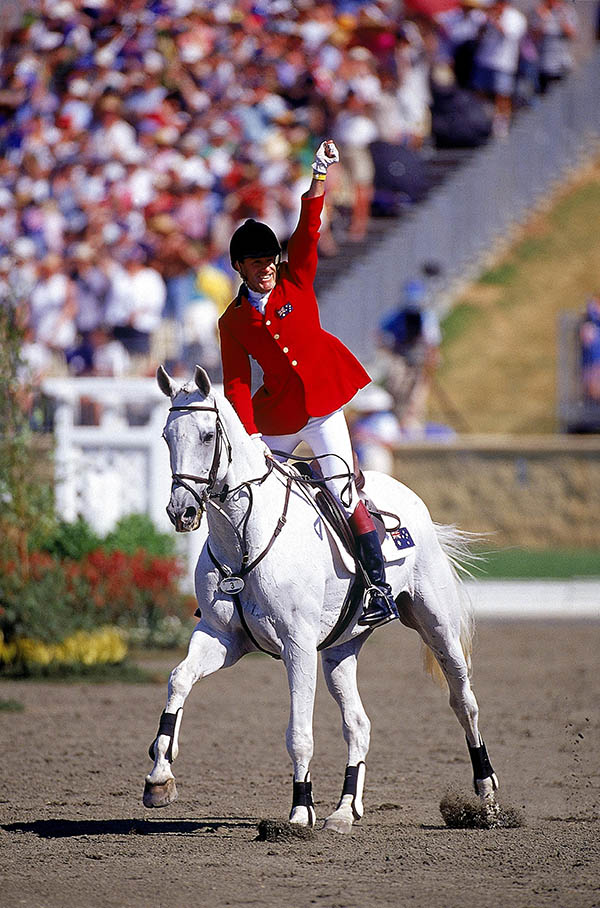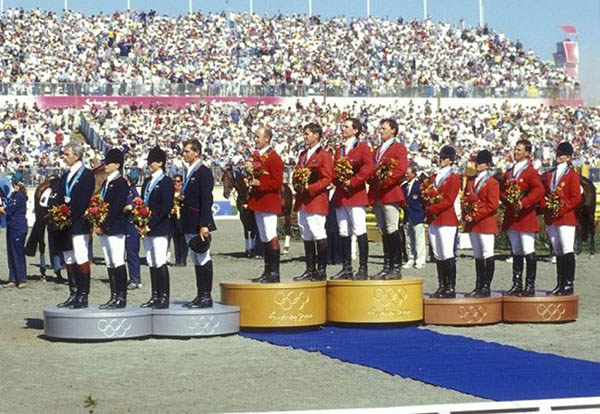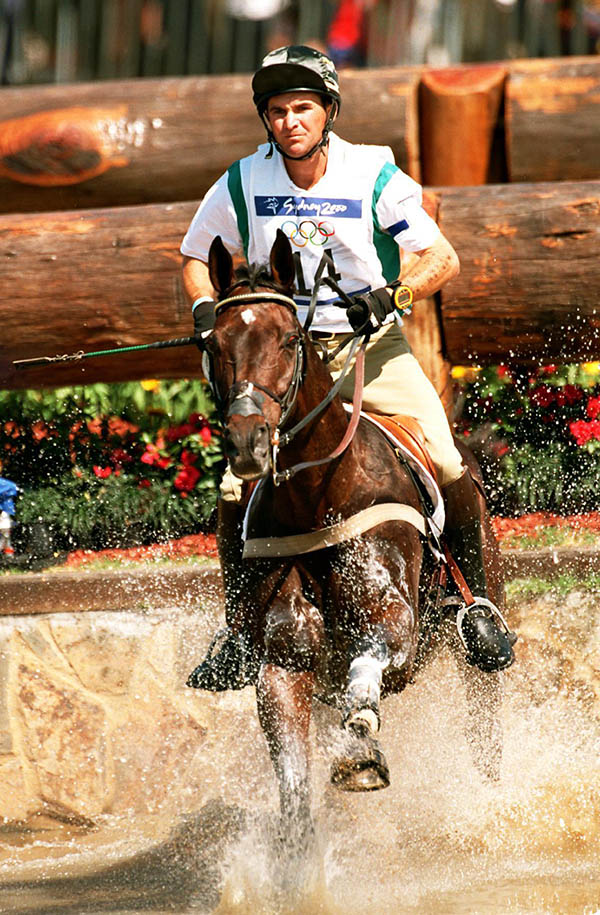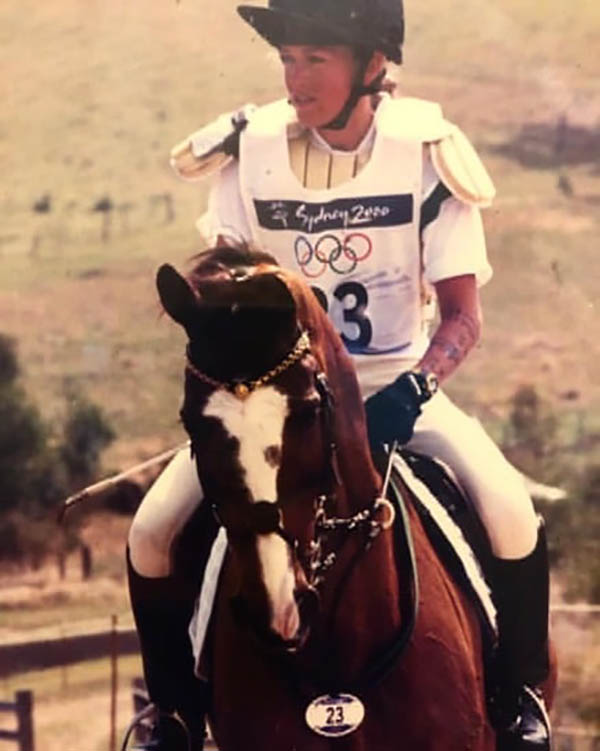When the IOC President Juan Antonio Samaranch declared the Sydney 2000 Games “the best Olympic Games ever”, the Australian equestrian community unequivocally agreed. It is now 24 years since our Dream Team of Stuart Tinney, Andrew Hoy, Matt Ryan and Phillip Dutton made history with a record-breaking third straight gold medal and launched equestrian sports into mainstream view.

“Stuart Tinney, Andrew Hoy,
Matt Ryan, Phillip Dutton…
dominated all three phases.”

Of the 16 gold medals Australia secured on home soil at the Games of the XXVII Olympiad, it’s quite possible that our Eventing team’s was the one that reaped the loudest, longest and most impassioned cheers. Stuart Tinney, Andrew Hoy, Matt Ryan, Phillip Dutton and their outstanding horses dominated all three phases of the Team Eventing competition, leading from start to finish and inspiring young and old as they catapulted equestrian sport into the general public’s view and onto the front page of national newspapers. Quite simply, it was a spellbinding performance that left us bursting with pride at Sydney 2000.
For those of us fortunate enough to have been at the Sydney International Equestrian Centre cheering with delight as our team clinched the gold, memories of that fine September day will forever hold a special place in our hearts. The world’s best were performing in our backyard, and as the Harbour City glistened under a seemingly constant sun, the Olympic spirit lifted athletes, volunteers and spectators alike to a state of golden greatness, imbuing the Olympic Movement’s values – Excellence, Respect and Friendship. We smiled, we screamed, and we cheered until we had no voices left to cheer with – we were witnessing, and indeed part of, one of the greatest Australian equestrian performances in history.
Having won back-to-back gold medals at Barcelona in 1992 and Atlanta in 1996, the Australian Eventing team were considered favourites to win the gold on home soil before the Games even commenced. Phillip Dutton and Andrew Hoy remained on the team from their 1996 triumph, while 1992 individual and team gold medallist Matt Ryan returned to the fold and Stuart Tinney debuted as the team’s only Australian-based rider. The horses’ experience varied; at one end of the scale, Phillip Dutton’s ride, House Doctor, at just 8 years old, was the youngest horse in the competition, whereas Andrew Hoy’s seasoned mount, Darien Powers, aged 15 at the time, had already proven his gold medal winning ability with Andrew in Atlanta. The stage was set, the pressure was on – would “The Dream Team” deliver the result we so hoped for?
Dressage day dawned. Andrew Hoy was out first for Australia, the third combination of the day to compete, and the crowd went wild when he appeared on the main arena. What Andrew and Darien Powers produced was more than a dressage test; it was a jaw-dropping performance that laid down the gauntlet for the rest of the competitors. Australia meant business, and Andrew’s score of 30.6 was unmatched across the two days of dressage competition. Stuart Tinney and Jeepster were next best for Australia with 36, with solid scores from Phillip Dutton and House Doctor, and Matt Ryan and Kibah Sandstone on 46 and 47.8 respectively. Australia had the First Phase lead it needed, however, a strong show from Great Britain’s team – Pippa Funnell, Ian Stark, Jeanette Brakewell and Leslie Law – meant little breathing room for the Australian team heading into the jumping phases.
On cross country day, a huge crowd flocked to SIEC in the scorching heat, happily travelling there on shuttle buses from various pick-up points around Sydney. As it was still the Old Format era, spectators had opportunities aplenty to see the Australian riders not only jumping around the cross country course, but also navigating their way around Roads and Tracks (Phases A and C), and the Steeplechase (Phase B). As riders – particularly the Australians – trotted into view at various points during the Roads and Tracks phases, they were greeted by the kind of cheers usually reserved for spectacular rides through complex water jumps. With many riders waving and acknowledging the crowd, there was a wonderful sense of camaraderie between Olympians and spectators alike. Whilst cheers for the Australians were unsurprisingly the most deafening, the veritable procession of the world’s greats – among them Mark Todd, Ian Stark, and Ingrid Klimke – seemed at times surreal and elicited cheers of encouragement and adulation; we’d never before in Australia, and possibly will never again, witness such an amazing line-up of eventing greats competing before our very eyes.

“Andrew’s score of 30.6
was unmatched across
the two days of dressage
competition.”
Australia’s reputation as a nation of brilliant and fiercely brave cross country riders was cemented that day. Stuart Tinney and Andrew Hoy made the stunning Mike Etherington-Smith designed track look easy, storming around clear and under time, the two fastest rounds of the day! Matt Ryan was just one second over the optimum time, adding a mere 0.4 penalties to his dressage score, with Phillip Dutton 4 seconds over and adding 1.6 penalties. At the end of the cross country phase no other nation could boast 4 rounds clear of jumping penalties – Australia had retained its lead with class and poise. Sore of foot and hoarse of voice after a day trekking up and down SIEC’s hills in the sun, the crowd was nevertheless elated. What a spectacle, what a day!
If one thing is certain after cross country day at a Long Format event, it’s that nothing is certain. A commanding lead, whilst promising, can become irrelevant very quickly if horses do not recover well enough from the gruelling cross country phase to complete the event, or disaster strikes during the show jumping phase. One can only imagine the nerves in the Australian camp between the final two phases – the efforts of the grooms, vets and support teams – and ultimately, the sense of relief when all horses passed the trot-up. The final day of competition had arrived, all horses made it through the trot-up and a gold medal was in Australia’s sights, so close they could almost touch it!
When the team was later inducted into the Equestrian Australia Hall of Fame in 2017, their coach Wayne Roycroft recalled at the awards ceremony: “I loved those horses, but they weren’t great jumpers!” At the time, a rail in the show jumping phase equalled 5 penalties, whereas in the current era it equates to 4 penalties. Each second over the optimum time attracts 1 penalty, and as riders walked the course it was clear that this was a tight track, to be ridden on tired horses who were carrying the weight of the nation. The competition was far from over! Great Britain were hot on our heels; 1999 Badminton winner Ian Stark had withdrawn after cross country, meaning all three of their rider’s scores had to count whereas Australia could afford one discard score. However, Great Britain’s three remaining team members had added just 0.4 penalties between them on cross country day. Australia’s total was 114.2, less than three rails in hand over Great Britain on 127. The USA were also in reach, carrying forward 160.8 penalties.


“We jumped every fence
with them, our hearts
in our mouths.”
I was one of around 20,000 people fortunate enough to be at SIEC that day, witnessing history being made. As a university student on a groom’s wage, I only had room in the budget for cross country tickets, and thought that in itself would be amazing enough. However, thanks to a generous boss who was happy to watch the historic moment on television at home while I took her ticket and chaperoned her 14-year-old daughter to Horsley Park, I found myself back at SIEC decked out in green and gold.
The atmosphere was electric, yet strangely relaxed, as though we were at a party. The mood was festive and people didn’t just smile, they grinned; we felt in part as though we were at a local event – everyone you knew seemed to be there – yet the person sitting to your left or right had travelled halfway round the world to be there and shared your excitement regardless of which flag they waved.
First out for the Australians was Matt Ryan and Kibah Sandstone; the fiery chestnut’s enthusiasm had been brilliantly channelled on course the previous day, and he looked ready to do it all again. The crowd sighed when they took a rail, then gasped with horror at the third last fence when Matt saw a long distance and Sandstone chipped in a stride, sending poles flying. Crisis averted, Matt got the job done and with two rails and two time penalties, our first Aussie was home.
When Phillip Dutton and House Doctor jumped a 16-penalty round, the crowd held its collective breath. The Brits and the Americans were confident, polished and jumping well; would Stuart Tinney and Andrew Hoy be able to hold on to Australia’s tenuous lead? It was so, so close.






“Even if I win another
gold medal, it won’t be like
that, that’s for sure.”

Enter Stuart Tinney and Jeepster – cool, calm and collected, or so they appeared from the stands! The pair did not miss a beat, meeting every fence in perfect rhythm and dropping just one rail. When they jumped clear over the last fence the crowd erupted with delight. Jumping to our feet, we roared with appreciation; Sydneysiders Stuart Tinney and Jeepster had finished the Olympics on a total score of 41! Ultimately, this was the best performance within the team competition; had the current system been in place at the time whereby, the individual medals are awarded based on performances within the team competition, Stuart Tinney would have won individual gold for Australia. At Sydney, the individual medals were decided by a completely separate event. Stuart was the best eventing rider in the world that day, in front of his home crowd, and we were as proud as punch!
One rider to go, and despite Great Britain’s best efforts, when Andrew Hoy entered the arena he did so with 5 rails in hand. “Aussie, Aussie, Aussie! Hoy, Hoy, Hoy!” – the crowd was on its feet again, cheering, willing a gold medal moment that was surely just minutes away from realisation. Then a hush, a retreat to our seats, and we could hear each footfall as the elegant grey Darien Powers and our most decorated Australian equestrian in history approached the first. We jumped every fence with them, our hearts in our mouths – some rails fell, then the moment came when there were fewer fences to jump than there were rails in hand and it was real, it was happening, we had won the gold!
No one wanted that day to end. It was magical, we were euphoric, this was a real-life fairy tale; a third consecutive medal for the Australian Eventing team and we weren’t reading about it, we were living it! During the victory lap, the riders basked in the glory of the moment. As Stuart Tinney described during the EA Hall of Fame induction in 2017: “We were told we were allowed to go twice around or something and they couldn’t get us out, we went around about five times! The crowd was amazing; my wife Karen, who helps me with the horses all the time – helps train them at home – was there. Everybody was there, all my friends were there. We live down the road really, so it was unbelievable and it will never happen again. Even if I win another gold medal, it won’t be like that, that’s for sure.”
For Wayne Roycroft, who coached the Australian Eventing team from 1988 to 2010, a period in which the team won four team and two individual medals, this was an incredible moment. “Sydney was the most extraordinary experience, and for me personally it was amazing,” he said.
After the Games, participation in equestrian sports in Australia grew, buoyed by the inspirational performance of our Australian heroes. Many Australian riders have been fortunate enough to compete at the SIEC since the Games; for the eventers, the experience is particularly nostalgic – 24 years on, some of the original cross country fences still form part of the course. Galloping down to the “Olympic water”, or flying over the Snake fence, it’s impossible not to remember that wonderful Sydney September, and the gutsy, record-breaking performance of our Australian Eventing Team.
Next issue: We look back at the Dressage and Para Dressage at Sydney 2000.
OUR GOLDEN HORSES
JEEPSTER
A New Zealand-bred thoroughbred born in 1987, Jeepster raced as Delphic Oracle. He had 22 starts, winning $17,000 in Australia. Retiring from racing at five, he was initially tried as a movie horse by Heath and Krissy Harris before moving on to the Tinneys. Described by Heath as a “tough customer”, he nevertheless showed jumping potential as well as learning a few tricks such as the Spanish walk and bowing during his time with the Harrises, stunts that he occasionally pulled in his eventing career! Stuart Tinney’s partnership with Jeepster commenced in 2003, and their international results included 1st in the 1997 Melbourne CCI3*, 2nd in the 2003 Adelaide International CCI4* and 9th at the 1998 World Equestrian Games in Rome. Quite incredibly, in 1998 he broke his stifle at an event in Britain, and after surgery vets said he would not compete again. He returned to eventing after nine months of physio, going on to win gold at Sydney two years after the injury.
Jeepster lived out his retirement with his biggest fans, the Tinney family in Marayla, Sydney, before sadly passing away in 2013 aged 26, due to lymphoma.
DARIEN POWERS
Born in Victoria in 1985, Darien Powers was by the Holsteiner-thoroughbred cross stallion Christofle and out of the thoroughbred mare, Bucks Queen. Christofle was by Flaneur, the first imported, licensed and performance-tested stallion in Australia. Andrew Hoy’s partnership with Darien Powers commenced when the horse was six years old; Sally Boyle had won a Wandin Young Horse competition with him in 1991, and Andrew rode the horse in the Novice class at Wandin the following year. In addition to winning team gold medals at the 1996 and 2000 Olympics, Darien Powers won the British Open title in 1997 with Andrew and retired in 2003.
KIBAH SANDSTONE
Born in 1984 in Carroll NSW, Kibah Sandstone was bred by Olympic Show jumper Bridget (Bud) Hyem. Sandstone was a half-sibling to Matt Ryan’s 1992 Olympic Gold medallist Kibah Tic Toc, being out of the same mare, Kibah Sandrift. Kibah Sandstone was by Bamborough Sunny Souvenir, and his bloodlines were predominantly thoroughbred. Like Kibah Tic Toc, Kibah Sandstone was originally campaigned by Bud’s daughter Lisa, with Matt taking on the ride later in the horse’s career.
Matt Ryan retired Kibah Sandstone in 2002 when the horse was 18, however, he enjoyed a brief second career some 10 years later when he came out of retirement at aged 28 to pilot Matt’s working pupil around some BE80 and BE90 courses. He lived to the grand age of 32.
HOUSE DOCTOR
An American thoroughbred, House Doctor was born in Maryland, USA, in 1992 and came to American-based Phillip Dutton as a three-year-old. Originally intended to be Phillip’s backup horse for the Games due to his age and inexperience, he stepped up to the role of team horse after Dutton’s top horse suffered some lameness in the lead up to the Games. Two years later at the World Equestrian Games in Jerez, Spain, the pair came close to clinching gold, holding second place after the cross country phase. However, the horse was sore after cross country, dropped to 5th, and needed a long recovery thereafter. He did return to competition with Phillip, but not on the international stage. EQ



